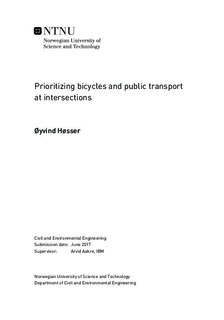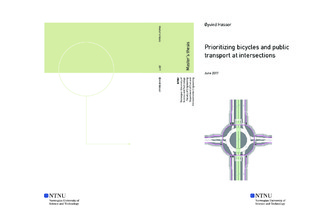| dc.description.abstract | Traffic growth leads to challenges regarding road capacities and pollution levels; locally and globally. Increasing attractiveness of public transport, biking, and walking is desired, as acknowledged environmentally friendly and passenger efficient transport modes. In urban areas in Norway, public transport and cyclists are often provided with dedicated lanes. At intersections, these dedicated lanes are traditionally terminated for allowing other movements of general purpose traffic. This reduces priority of public transport and bicycles, and associated attractiveness. Pedestrians are traditionally provided with high priority in the current road network. This is intendedly preserved. Objective of the thesis is investigating a way to improve priority of bicycles and public transport at intersections.
Buses are investigated as public transport mode as the most used public transport service in Norway. Other limitations to the thesis are at-graded junctions with buses entering and exiting along one axis due to one major and one minor road connecting; four-way intersection. Right-hand driving rules are considered.
Priority of bicycles and public transport is improved through a new intersection design. The experimental design is acknowledged as a throughabout as lanes penetrate the central island of a traditional roundabout. Buses are provided with absolute priority through the central island in segregated meridian bus lanes, resulting in no delay for buses. Cyclists are provided with a continuous, one-way regulated circulatory bike lane segregated from other motorised traffic. At conflict points, cyclists have higher priority, except for the busway where buses have absolute priority. Pedestrians are also obliged to give way for buses, but have highest priority at all other crossings.
The experimental design consists mostly of elements from other existing designs. Though elements are known separately, a similar throughabout with these elements combined are not found. Assessment and analyses are performed by modelling and simulations in traffic software: SIDRA INTERSECTION 7.0.5 and AIMSUN 8.2.0. SIDRA INTERSECTION is used for investigation of conflict points in the circulatory lane between buses and general purpose traffic. AIMSUN is used for investigation of the full design with all transport modes interacting. Traffic management and traffic safety are main focus for assessment of the design.
Based on tested scenarios with defined volumes and movements; cyclists and pedestrians are rarely affected by other transport modes, and buses not affected at all. General purpose traffic sees most delay in the network with lowest priority. By back of queue results at conflict points in the circulatory lane from SIDRA INTERSECTION, buses do not have a severe impact on general purpose traffic with volumes of 350 veh/h or lower. Larger flows result in problematic queues; blockage of other traffic. Results from AIMSUN show that different tested bus frequencies do not impact general purpose traffic, though lower frequencies are tested compared to SIDRA INTERSECTION. The biggest impact on delay for general purpose traffic is respective volume. Frequencies of cyclists and pedestrians also contribute. Cyclists and pedestrians are not notably impacted by general purpose traffic; mainly impacted by respective volumes. By tested flows in AIMSUN, different bus frequencies are not affecting other transport groups.
Crossings between general purpose traffic and buses are exposed conflict points. These movements are not frequent for general purpose traffic as most traffic is assumed to continue the main road. In tested scenarios in AIMSUN, these movements are performed by 25 % of all general purpose traffic. Give way regulated crossings are not assumed to be a problem for these transport modes as similar solutions exist today with passing trams. General purpose drivers are considered by separating conflict points from each other, thus; focusing on one conflict point at a time. This preserves traffic safety for all transport modes at the throughabout. Unsignalised crossings over the busway for pedestrians and cyclists can lead to severe impacts with buses. Traffic safety is preserved by low bus speeds of 40 km/h, designated crossings with an additional signalised crossing, implemented waiting spaces, and universal design.
Assessment of the design is based on traffic software; a simplification of reality. Investigated scenarios in this Master s thesis give an indication of occurring queues and delays for selected traffic volumes and associated movements at presented design. More analyses should be performed by test of more scenarios with greater variations in volumes and movements, and larger scaled models with close monitoring. This thesis constitutes a basis for further investigation and development of the design. | |

